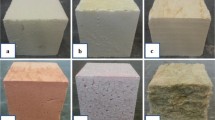Abstract
Results of large-scale and bench-scale tests are reported on three EIFS (exterior insulation and finish systems) type façade assemblies. The large-scale tests were done according to a modified SP 105 test, while the bench-scale procedures followed CAN/ULC-S135. The tests were motivated by the current ISO deliberations to select an optimal international standard for testing façades against fire propagation hazards. The large-scale test showed distinct differences among the assemblies tested. However, certain difficulties were identified with the test, especially the smokiness of the fuel and the non-ideal dimensioning of the re-entrant corner. The bench-scale tests showed consistent results; such procedures may be useful for screening purposes.
Similar content being viewed by others
References
Willey, A. E., “High-Rise Building Fire,”Fire Journal, Vol. 66 (July, 1972), No. 5.
Sharry, J. A., “South America Burning,”Fire Journal, Vol. 68 (July 1974), No. 5.
Hildebrand, C., “Façade Fire Tests,” Workshop report, Institut für Baustoffe, Leipzig, Germany, 1988.
Method of Test for the Evaluation of Flammability Characteristics of Exterior, Nonload-Bearing Wall Panel Assemblies Using Foam Plastic Insulation (UBC Standard 26-4). 1994 Uniform Building Code, Vol. 3, pages 3–799 to 3–814. International Conference of Building Officials, Whittier, California (1994).
Standard Method of Fire Test of Exterior Wall Assemblies (CAN/ULC-S134-92). Underwriters Laboratories of Canada, Scarborough, Ontario, 1992.
Sumathipala, K., “The Effect of an Interior Corner on Exterior Wall Fire Spread,” poster presented at First European Symposium of Fire Safety Science, International Association of Fire Safety Science, Zurich, 1995.
Sumathipala, K.,et al. “Exterior Wall Fire Spread of Combustible Cladding Assemblies,” National Research Council Canada, Ottawa, 1995.
Ondrus, J., “Fire Hazards of Façades with Externally Applied Additional Thermal Insulation: Full Scale Experiments (LUTVDG TVBB-3021),” Lund University, Lund, 1985.
Hermodsson, T., and Månsson, L., “Façades: Fire Testing of Materials and Constructions—A First Proposal for a Test Method (SP AR 1992:64),” Swedish National Testing and Research Institute, Borås, 1992.
Babrauskas, V., and Grayson, S. J., eds.,Heat Release in Fires, Elsevier Applied Science Publishers, London, 1992.
Ibid, “The Cone Calorimeter.”
Standard Method of Test for Determination of Degrees of Combustibility of Building Materials Using an Oxygen Consumption Calorimeter (Cone Calorimeter), National, CAN/ULC-S135-92, Underwriters' Laboratories of Canada, Scarborough, Ontario, Canada, 1992.
Richardson, L. R., and Brooks, M. E., “Combustibility of Building Materials,”Fire and Materials 15 (1991), pp. 131–136.
Author information
Authors and Affiliations
Rights and permissions
About this article
Cite this article
Babrauskas, V. Façade fire tests: Towards an international test standard. Fire Technol 32, 219–230 (1996). https://doi.org/10.1007/BF01040215
Issue Date:
DOI: https://doi.org/10.1007/BF01040215




